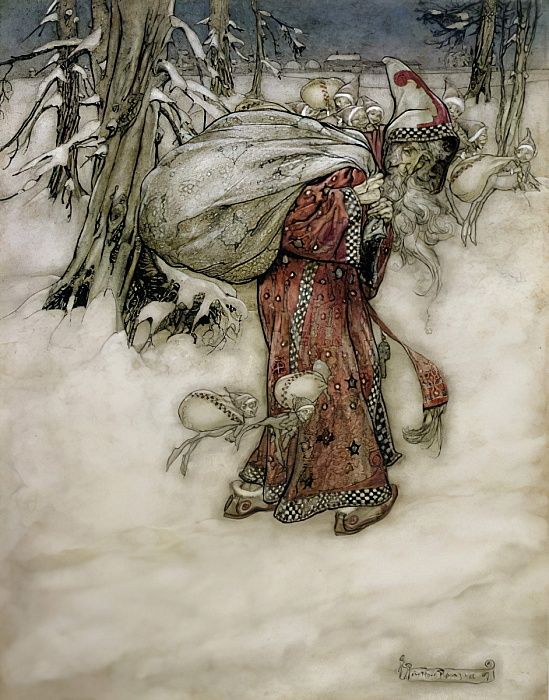by Cynthia Close
The ornate, magical, curvilinear pen and ink drawings of English book illustrator Arthur Rackham (1867-1939) animated many literary classics like the Fairy Tales of the Brothers Grimm, Gulliver’s Travels, Aesop’s Fables, Rip Van Winkle, and Alice’s Adventures in Wonderland. His illustrated books were often elaborately bound and published, and intended to be gifts for holiday giving. Rackham benefitted by the developments in turn of the century print technology. The use of photography, rather than the arduous craft of engraving for print, made it possible for the subtle introduction of color and directly captured the intricate linear detail of his drawings as seen in his 1907 depiction of Santa Claus.

The mythic origins and transition from Saint Nicholas to Santa Claus remain murky. They are intertwined with the battle between religion and politics over the celebration Christmas in 17th century England. The Puritans opposed the celebration of Christmas. They considered it a pagan event, providing cover for the encouragement of ungodly behavior. They wanted to cleanse Christianity of its Catholic traditions. English writers in response personified the holiday in a Father Christmas figure, a more secular vision. Rackham’s Santa Claus does not sport the characteristic rotund belly. He is a rather lean figure, but strong enough to carry the huge sack, presumably full of gifts. He labors through deep snow but is helped by the bevy of fairies, precursors to Santa’s elves, flitting around him. The fairies are also carrying bundles, perhaps full of wishes rather than tangible gifts. (Note that their hats bear a resemblance to those of elves today.) His age is confirmed by the long, flowing tendrils of his white beard, and he wears a red ankle length robe with signs and symbols suggestive of his status as a magician. He has no visible means of transportation; our imaginations are left to fill in the gaps.



:strip_icc()/BHG_PTSN19720-33d9cd22f6ab49e6a21982e451321898.jpg)

More Stories
BSA Film Friday: 11.25.22 | Brooklyn Street Art
FEATURES – Art in VR with Casey Koyczan
Julie Karpodini: Painting Instinct – Jackson’s Art Blog